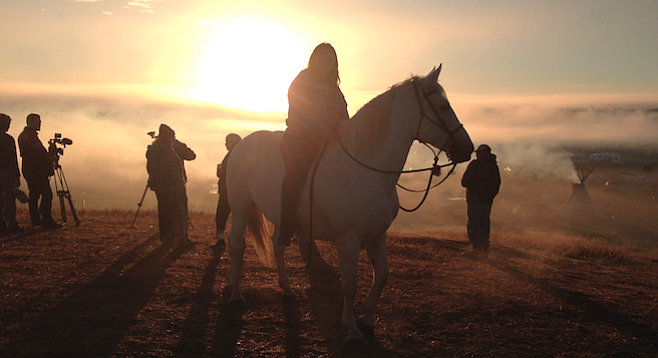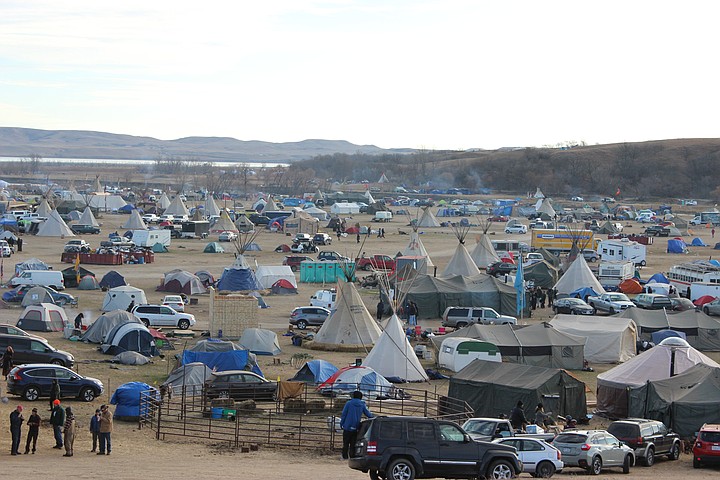 Facebook
Facebook
 X
X
 Instagram
Instagram
 TikTok
TikTok
 Youtube
Youtube

“I just got back from the Standing Rock Dakota Access Pipeline protests [in Cannonball, North Dakota],” says singer/songwriter Scott Wilson. “I edited a short video on the issues surrounding why they’re protesting the construction of an oil pipeline that would pass under the Missouri River, which provides 18 million people with drinking water.”
Between albums, Wilson keeps busy editing video footage, including music promos like the Goo Goo Dolls’ cover of Supertramp’s “Give a Little Bit,” TV shows like Rock Star: INXS, and musical documentaries like Under the Electric Sky, chronicling the 2013 Electric Daisy Carnival. He’s also shot music videos for locals Seaholm Mackintosh, Jeffrey Joe Morin, and Podunk Nowhere, but this latest project is more about message than music.
“There are thousands of people at the Standing Rock camp right now and, until yesterday, there was virtually no national coverage on the protests outside social media. It was eye opening to see how peaceful protest actually works, and horrifying to see what the reaction is on the law enforcement side of the equation, with a pipeline that is being built without proper permitting and environmental impact studies.
“Like many, I did not know the details of what was happening at Standing Rock, and the first time I crossed that bridge and drove into that camp, I was in awe of the size and scope... As I explored the camp, the sense of teamwork, camaraderie, and selflessness was staggering.”
Wilson worked with videographer Todd Darling, who has been shooting footage at Standing Rock since September. During his week at Standing Rock, Wilson edited a short film, Call to Action, using portable equipment set up at the local community center.
“The center was filled with reporters that were blogging and reporting on the protests, and at one point there was a roomful of women dancing to Daft Punk’s ‘Get Lucky,’ but I was too busy to even look up at that point, unfortunately. I was wearing headphones, but it occasionally got distracting in there with all the things that were happening in the background. I’ve been in an edit bay during an earthquake, but never with a roomful of women dancing to Daft Punk.”

“A few days after I left, there was a confrontation with law enforcement where militarized police officers shot people with water cannons and rubber bullets...water protectors were taken to this same community center to be treated for their injuries.”
Accommodations were rugged. “I camped on the south side of the Cannonball River, which is the reservation side…it’s cold. Not a lot of showers. Occasional explosions of intense police violence. Possible arrest, harassment, indiscriminate shooting, and police eavesdropping. How could anyone turn that down?”
Still, he found himself surrounded by positivity. “There are six mess tents there that are feeding thousands of people, three times a day. There are places where they’re giving away clothes to people who are preparing for the snow of a harsh North Dakota winter. There are people sewing yurts, people doing water ceremonies, people carrying water buckets, people putting out fires, people cooking meals for strangers. People beating on giant water drums and singing with incredible passion. People looking after other people.”
The video edits were started late on a Thursday afternoon, and uploaded to YouTube that Sunday. “I also added some drum loops with my laptop using GarageBand.”
Wilson is pleased that the protests are finally earning press coverage. “To the world, Standing Rock is like a bubble. No one from the outside really knows exactly what’s happening there. There are dribs and drabs of information that escape the bubble, but the cooperative spirit of the place is totally invisible to the outside world.”
“When you’re in Standing Rock, the world is the bubble.”


“I just got back from the Standing Rock Dakota Access Pipeline protests [in Cannonball, North Dakota],” says singer/songwriter Scott Wilson. “I edited a short video on the issues surrounding why they’re protesting the construction of an oil pipeline that would pass under the Missouri River, which provides 18 million people with drinking water.”
Between albums, Wilson keeps busy editing video footage, including music promos like the Goo Goo Dolls’ cover of Supertramp’s “Give a Little Bit,” TV shows like Rock Star: INXS, and musical documentaries like Under the Electric Sky, chronicling the 2013 Electric Daisy Carnival. He’s also shot music videos for locals Seaholm Mackintosh, Jeffrey Joe Morin, and Podunk Nowhere, but this latest project is more about message than music.
“There are thousands of people at the Standing Rock camp right now and, until yesterday, there was virtually no national coverage on the protests outside social media. It was eye opening to see how peaceful protest actually works, and horrifying to see what the reaction is on the law enforcement side of the equation, with a pipeline that is being built without proper permitting and environmental impact studies.
“Like many, I did not know the details of what was happening at Standing Rock, and the first time I crossed that bridge and drove into that camp, I was in awe of the size and scope... As I explored the camp, the sense of teamwork, camaraderie, and selflessness was staggering.”
Wilson worked with videographer Todd Darling, who has been shooting footage at Standing Rock since September. During his week at Standing Rock, Wilson edited a short film, Call to Action, using portable equipment set up at the local community center.
“The center was filled with reporters that were blogging and reporting on the protests, and at one point there was a roomful of women dancing to Daft Punk’s ‘Get Lucky,’ but I was too busy to even look up at that point, unfortunately. I was wearing headphones, but it occasionally got distracting in there with all the things that were happening in the background. I’ve been in an edit bay during an earthquake, but never with a roomful of women dancing to Daft Punk.”

“A few days after I left, there was a confrontation with law enforcement where militarized police officers shot people with water cannons and rubber bullets...water protectors were taken to this same community center to be treated for their injuries.”
Accommodations were rugged. “I camped on the south side of the Cannonball River, which is the reservation side…it’s cold. Not a lot of showers. Occasional explosions of intense police violence. Possible arrest, harassment, indiscriminate shooting, and police eavesdropping. How could anyone turn that down?”
Still, he found himself surrounded by positivity. “There are six mess tents there that are feeding thousands of people, three times a day. There are places where they’re giving away clothes to people who are preparing for the snow of a harsh North Dakota winter. There are people sewing yurts, people doing water ceremonies, people carrying water buckets, people putting out fires, people cooking meals for strangers. People beating on giant water drums and singing with incredible passion. People looking after other people.”
The video edits were started late on a Thursday afternoon, and uploaded to YouTube that Sunday. “I also added some drum loops with my laptop using GarageBand.”
Wilson is pleased that the protests are finally earning press coverage. “To the world, Standing Rock is like a bubble. No one from the outside really knows exactly what’s happening there. There are dribs and drabs of information that escape the bubble, but the cooperative spirit of the place is totally invisible to the outside world.”
“When you’re in Standing Rock, the world is the bubble.”
Comments